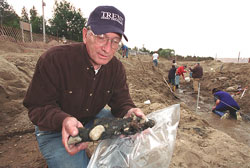
| Daily News | News Releases | Special Bulletins | Feature Archives |
| The View from Trent | Trent Magazine | Focus Trent | Build 2000 |
Bringing
out the big guns:
Archaeologist discovers cannon from late 1700s shipwreck
 Archaeologist
Ken Cassavoy, a long-term research associate of Trent University, made
a thrilling discovery this past October.
Archaeologist
Ken Cassavoy, a long-term research associate of Trent University, made
a thrilling discovery this past October.
On a dig at Southampton Beach, on Lake Huron, Mr. Cassavoy found a cannon buried in the sand alongside the remains of a late 1700s sailing vessel. The 200-pound weapon would have been mounted on the rail of the ship, at the bow or stern.
To non-archaeologist types, this discovery might seem fairly tame. But Mr. Cassavoy explains that unearthing a cannon on a Great Lakes beach is anything but mundane.
"The cannon was a particularly exciting find. I don’t know of any other cannon found in any excavation or investigation of Great Lakes shipwrecks, outside of War of 1812 vessels," says Mr. Cassavoy. "As well, the cannon type and style and structural information from the October dig suggest it is a late 1700s ship. Again, finding a ship of this period on the Great Lakes, especially the upper lakes, is extremely rare."
Just why was this ship plying the waters of Lake Huron, equipped with weapons? And what circumstances culminated in the fateful grounding on Southampton shores? These questions are difficult to answer, and contribute to the mystery Mr. Cassavoy is attempting to unravel.
He does know that the ship was a two-masted schooner, as evidenced by two mast steps discovered during excavation. These steps marked the location of the former foremast and main mast. The ship was five metres wide and five metres long. The bow of the ship was buried about one metre below the surface of the beach, with the stern about two metres below the surface.
A recent discovery by Tobermory historian Patrick Folkes may help identify the ship. He has discovered a letter that refers to a boat called the "Weasel" that was lost in the Southampton area before 1808. The "Weasel" was built in 1786, in Detroit, for John Askin, a prominent merchant, and carried muskets, rum, flour, fish and other goods between Fort Erie, Detroit, Sault Ste. Marine and Michilimakinac during the late 1700s. References to the ship end before 1800. Given the relatively small number of vessels on the lake during this period, the "Weasel" is a strong candidate for identification as the Southampton wreck, although Mr. Cassavoy cautions that additional research will need to completed before any identification is made.
The vessel was initially discovered in April of 2001, when a resident went for a walk along the beach and saw a piece of wood sticking out of the sand. Magnetic testing was done and indicated there was metal beneath the sand. Excavation work followed.
Over the winter, digging has been stopped and the site has been recovered with sand. The cannon is being stored in a water tank to prevent rusting, and Mr. Cassavoy is hopeful that identifying marks on the cannon will be researched thoroughly.
For years, Mr. Cassavoy taught an underwater archaeology class at Trent, and is hoping to offer a summer course to Trent students this coming summer, to work on the Southampton dig.
"We are tentatively planning a Trent field school for May and June of this coming year. The work would involve the excavation of the major part of the vessel," says Mr. Cassavoy, adding that the viability of the course will depend on the number of interested students, as well as some funding and logistical issues.
For information about the 2003 summer field school, please contact Julian Blackburn College (705-748-1229) or the Anthropology Department (705-748-1011, ext. 1325).
Photo: In October of 2002 Trent research associate Ken Cassavoy discovered a cannon dating to the late 1700s alongside a two-masted schooner on a Lake Huron beach. This find is extremely rare and raises a new historical mystery to the forefront of archaeological research in Ontario. He is pictured here holding a smaller artifact from the ship.
Posted December 10, 2002
![]() Return to Trent Home
Return to Trent Home
Maintained by the Communications
Office
Last updated
January 3, 2003